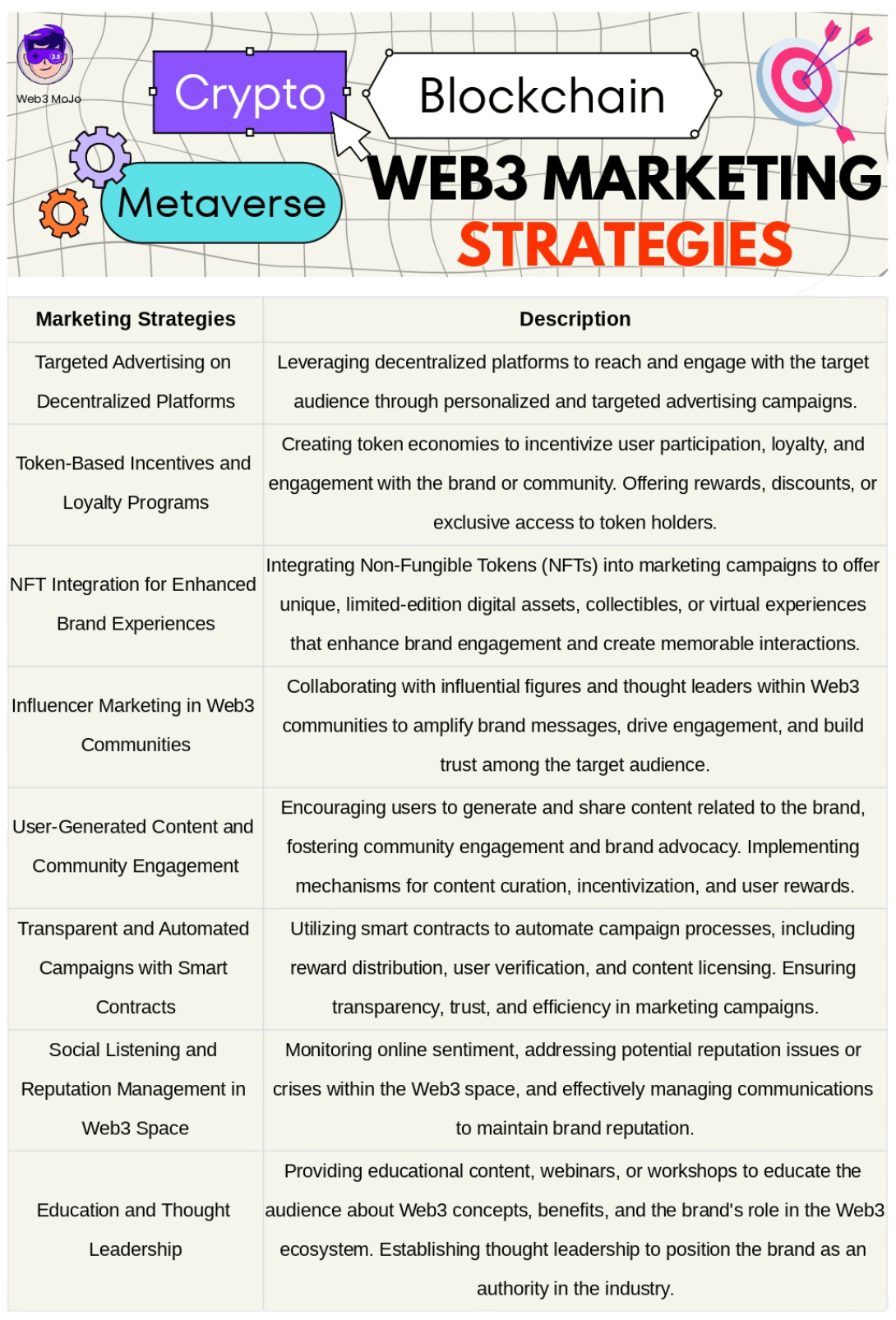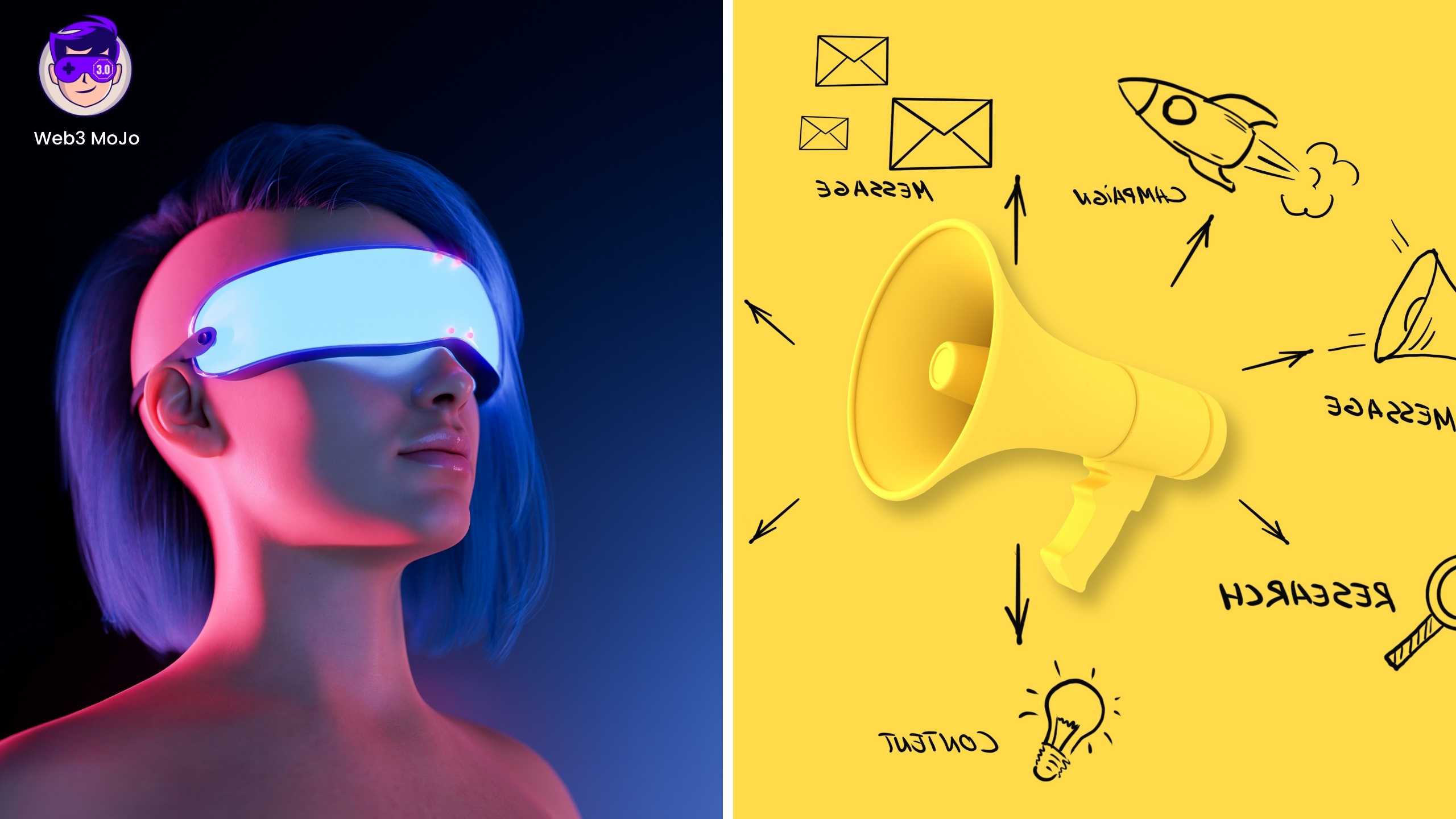I. Introduction
Web3 refers to the third generation of the internet, which is built on decentralized technologies, blockchain, and smart contracts. Unlike Web2, which focused on centralized platforms and intermediaries, Web3 empowers individuals by giving them control over their data, enabling peer-to-peer transactions, and fostering transparency and trust. In the marketing industry, Web3 represents a paradigm shift, revolutionizing how brands connect with their audiences and conduct business.
Overview of the shift from Web2 to Web3 and its impact on marketing
The transition from Web2 to Web3 is transforming the marketing landscape. Web2 platforms, such as social media networks and online marketplaces, relied on centralized control, monetizing user data, and generating revenue through advertising. In contrast, Web3 embraces decentralization, token economies, and user sovereignty. This shift has profound implications for marketing, as it introduces new avenues for engagement, innovative monetization models, and increased user empowerment.
Brands that embrace transparency and decentralization will win the future. – Lisa Gansky, Entrepreneur & Author of The Mesh
II. Understanding Web3 Marketing
A. Explaining the core principles and technologies of Web3
Web3 marketing revolves around the principles of decentralization, transparency, and user ownership. It leverages technologies like blockchain, decentralized applications (dApps), and smart contracts to create a more inclusive and participatory marketing ecosystem. By eliminating intermediaries and enabling direct peer-to-peer interactions, Web3 marketing empowers users and fosters trust and transparency.
B. The role of blockchain, cryptocurrencies, and decentralized platforms in Web3 marketing
Blockchain technology forms the foundation of Web3 marketing. It provides a secure and transparent infrastructure for storing and verifying data, enabling trustless interactions between parties. Cryptocurrencies play a vital role as the native tokens of Web3 platforms, facilitating transactions, incentivizing user participation, and creating new monetization models. Decentralized platforms, powered by blockchain, allow marketers to engage directly with their target audience, bypassing traditional gatekeepers.
C. Key characteristics and advantages of Web3 marketing over traditional approaches
Web3 marketing offers several advantages over traditional approaches. It enables greater control and ownership of personal data, addressing privacy concerns prevalent in Web2. With token economies and incentivization mechanisms, Web3 marketing fosters active user engagement and loyalty. The transparency of blockchain ensures ad fraud mitigation and provides verifiable analytics. Additionally, Web3 marketing opens doors to new revenue streams through NFTs, tokenized assets, and decentralized marketplaces.
By embracing Web3 marketing, brands can forge stronger connections with their audience, build trust through transparent interactions, and tap into the innovative potential of decentralized technologies. This shift represents an exciting opportunity for marketers to reimagine their strategies and adapt to the evolving digital landscape.
III. Web3 Marketing Strategies
A. Leveraging decentralized platforms for targeted advertising and user engagement
Web3 marketing leverages decentralized platforms, such as decentralized social networks or blockchain-based content platforms, to reach and engage with the target audience. These platforms provide direct access to engaged communities, allowing marketers to deliver targeted messages and content. By tapping into these decentralized platforms, marketers can benefit from a more engaged and receptive audience that values privacy, transparency, and user sovereignty.
B. Harnessing the power of blockchain and smart contracts for transparent and automated campaigns
Blockchain and smart contracts bring transparency and automation to marketing campaigns in Web3. Smart contracts enable the creation of self-executing agreements, automating processes like reward distribution, user verification, and content licensing. Marketers can use blockchain to track and validate the provenance of digital assets, ensuring authenticity and combating fraud. This transparency and automation foster trust and efficiency in marketing campaigns.
C. Embracing token economies and incentivization to drive user participation and loyalty
Web3 marketing embraces token economies, where digital tokens serve as a means of exchange, incentivization, and value creation. Brands can create their own tokens to reward user engagement, loyalty, and contributions to the community. Token-based incentive systems encourage users to participate actively, such as sharing content, providing feedback, or referring others. This fosters a sense of ownership, community, and loyalty, driving user engagement and brand advocacy.
D. Integrating NFTs and digital collectibles in marketing campaigns for enhanced brand experiences
Non-Fungible Tokens (NFTs) have gained significant traction in Web3 marketing. Brands can leverage NFTs to create unique digital collectibles, limited editions, or virtual experiences that engage and excite their audience. NFTs provide an opportunity to unlock exclusive content, access special events, or offer virtual assets tied to the brand. By integrating NFTs into marketing campaigns, brands can offer immersive and memorable brand experiences, enhancing their connection with the audience.
Blockchain marketing is about giving control back to users, not platforms. – Richard Hendrickson, Web3 Growth Strategist
These Web3 marketing strategies offer innovative and immersive approaches to engage with the audience, harness the power of decentralized technologies, and create unique brand experiences. By embracing these strategies, marketers can navigate the evolving digital landscape and establish a competitive edge in the Web3 era.

IV. Case Studies: Successful Web3 Marketing Campaigns
A. Highlighting real-world examples of brands that have embraced Web3 marketing
In this section, we will showcase real-world examples of brands that have successfully implemented Web3 marketing strategies. We will explore how these brands leveraged decentralized platforms, token economies, smart contracts, and NFTs to engage their audience, build brand loyalty, and drive business growth. The case studies will demonstrate the innovative approaches taken by these brands and the positive outcomes they achieved through their Web3 marketing campaigns.
B. Demonstrating the positive outcomes and benefits achieved through innovative strategies
In this part, we will delve into the specific outcomes and benefits that these brands experienced as a result of their Web3 marketing efforts. We will highlight metrics such as increased user engagement, higher conversion rates, improved brand reputation, and enhanced customer loyalty. Through these case studies, we will emphasize the transformative power of Web3 marketing and how it can contribute to the overall success of a brand in the digital age.
V. Web3 Marketing Challenges and Considerations
A. Regulatory landscape and compliance with evolving laws
Web3 marketing operates within a complex regulatory environment that is constantly evolving. We will discuss the challenges brands face in adhering to existing regulations and adapting to emerging ones, such as data privacy, intellectual property rights, and securities regulations. We will explore how brands can navigate these challenges by staying informed, seeking legal guidance, and implementing robust compliance measures.
B. Navigating scalability issues and transaction costs
Web3 marketing faces scalability challenges due to the limitations of current blockchain technologies. We will delve into the issues related to network congestion, transaction speed, and high fees. We will explore potential solutions and workarounds that brands can employ to mitigate these challenges, such as layer-two solutions, interoperability, and optimizing gas fees.
C. Overcoming user adoption barriers and educating audiences about Web3 concepts
One of the key challenges in Web3 marketing is educating audiences about the fundamental concepts and benefits of Web3. We will discuss the barriers to user adoption, including technical complexity, lack of awareness, and resistance to change. We will provide insights into effective strategies that brands can employ to educate and onboard their target audience, such as user-friendly interfaces, educational content, and interactive experiences.
By addressing these challenges and considerations, brands can position themselves strategically in the Web3 marketing landscape, mitigate risks, and maximize the potential of their Web3 marketing initiatives.
VI. The Future of Web3 Marketing
A. Predictions and trends for the future of marketing in the Web3 era
In this section, we will explore the potential trajectory of Web3 marketing and discuss emerging trends that are likely to shape the industry. We will delve into topics such as the integration of artificial intelligence and machine learning in Web3 marketing, the rise of decentralized identity solutions, the impact of virtual and augmented reality on brand experiences, and the growth of cross-chain interoperability. By examining these predictions and trends, we aim to provide marketers with insights into the future direction of Web3 marketing.
B. Opportunities and potential for marketers to leverage Web3 technologies and platforms
We will highlight the exciting opportunities that Web3 technologies and platforms present for marketers. From leveraging decentralized platforms for targeted advertising and user engagement to harnessing blockchain for transparent and secure transactions, marketers can tap into a range of tools and strategies to enhance their marketing efforts. We will discuss how marketers can leverage token economies, NFTs, and decentralized finance to create new revenue streams and foster deeper connections with their audience. By embracing these opportunities, marketers can position themselves at the forefront of the Web3 revolution.
Decentralization isn’t just a buzzword—it’s the foundation of the next marketing era. – Alex Tapscott, Co-Author of Blockchain Revolution
VII. Conclusion
We will conclude the article by encouraging marketers to embrace Web3 marketing as a strategic approach for sustained growth and success. By adapting to the changes brought about by Web3, marketers can gain a competitive edge, connect with their audience on a deeper level, and explore new opportunities for innovation and revenue generation. We will highlight the importance of continuous learning, experimentation, and staying ahead of the curve in the rapidly evolving Web3 marketing landscape.
By providing a comprehensive outline of the article, we can cover the key aspects of the rise of Web3 marketing, its future potential, and the opportunities it presents for marketers.
FAQs
Web3 faces several challenges, including regulatory uncertainties and compliance with evolving laws, scalability issues, high transaction costs, user adoption barriers, and educating audiences about Web3 concepts. Overcoming these challenges requires careful navigation, staying informed, and implementing strategies to address each specific challenge.
Web3 has a profound impact on marketing by introducing decentralized platforms, blockchain technology, cryptocurrencies, and token economies. It enables increased transparency, user ownership of data, and more personalized and targeted advertising. Web3 also fosters deeper engagement with audiences through NFTs, community involvement, and token-based incentives. Overall, Web3 reshapes the marketing landscape, emphasizing user-centric approaches, trust, and innovation.
Web3 marketing differs from traditional marketing approaches in several ways. It emphasizes decentralization, transparency, and user empowerment. Web3 marketing leverages blockchain technology, smart contracts, and token economies to create unique user experiences, foster community engagement, and incentivize user participation. It embraces a more personalized and targeted approach while focusing on building trust and authenticity with the audience.
To market a Web3 product effectively, it is important to understand the target audience and their needs within the Web3 ecosystem. Key strategies include leveraging decentralized platforms for targeted advertising, harnessing community engagement and influencers, integrating token economies and incentives, showcasing the unique features of the product, and educating the audience about the value it brings in the Web3 context. Collaborating with Web3 communities and utilizing thought leadership can also be effective marketing strategies.
The market size of Web3 marketing is continuously evolving and can be challenging to quantify precisely. As Web3 technologies gain broader adoption and more brands embrace Web3 marketing strategies, the market size is expected to grow significantly. With the increasing interest in decentralized platforms, blockchain-based advertising, and token economies, Web3 marketing presents a substantial opportunity for growth and innovation within the broader marketing industry.
Promoting a Web3 project requires a targeted approach within the Web3 ecosystem. Key strategies include leveraging Web3 communities, influencers, and thought leaders to amplify your project’s message. Engaging in active communication, providing educational content, hosting events, and participating in industry conferences and forums can also help raise awareness. Utilizing social media, content marketing, and community engagement tactics specific to the Web3 space can further promote your project and attract interested users and investors.
